YOUnite supports OAuth authentication with the Open ID Connect protocol. This guide shows how to set up Keycloak (https://www.keycloak.org/) with Open ID Connect to work with YOUnite’s services. This document does not detail how to install Keycloak itself, just how to configure it to work with YOUnite.
|
Note
|
Keycloak is not the only supported identity provider, any Open ID Connect compliant provider should work. |
Workflow Diagram
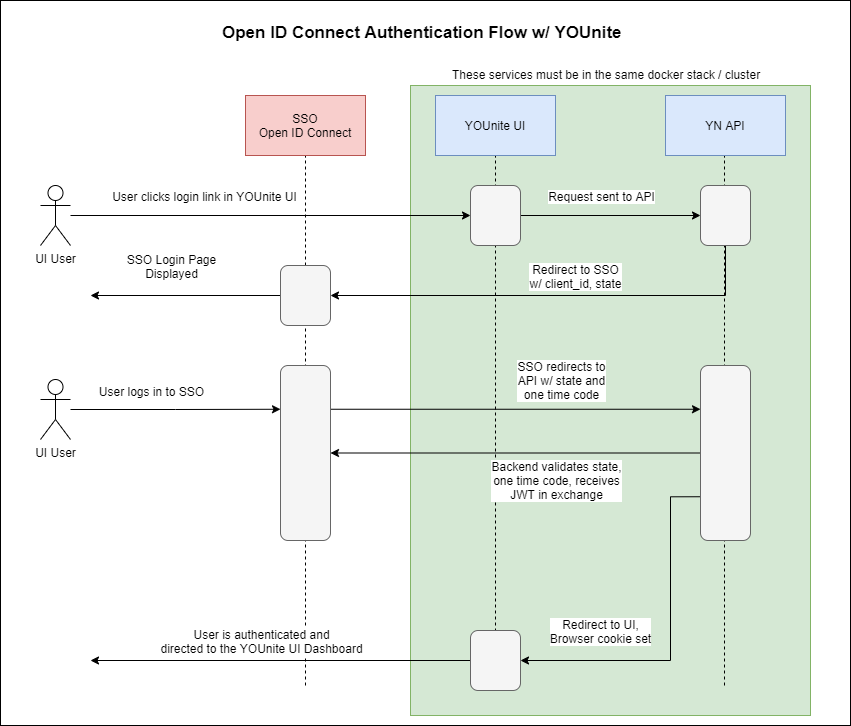
Setting Up Keycloak
Configure the Realm
You can use an existing realm or create a new realm in Keycloak. For this example we created a realm called younite.
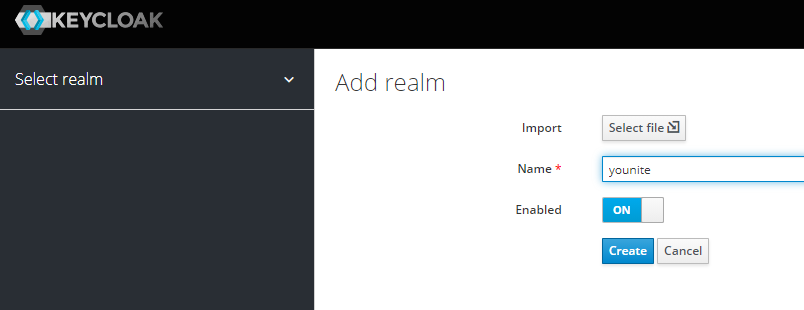
Configure Clients used by YOUnite and the Notification Service
The YOUnite Server acts as a "Resource Server" and requires a client with the "Standard Flow" enabled so that it can send users to Keycloak for authentication.
See Managing Resource Servers for more information on this flow.
Additionally, a client is required so that the YOUnite Notification Service can communicate with the YOUnite Server. This client acts as a "service account", ie it’s used by a service to authenticate and therefore cannot be presented with a login page.
Creating the Client for the YOUnite Server
Under Clients, select add client and choose openid-connect as the client protocol. You may choose any
client ID you choose, in this example we’re calling it younite.
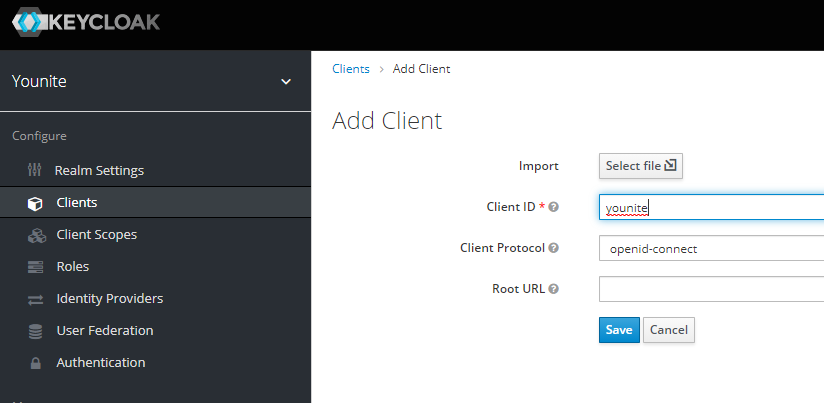
On the next page, set up your client like so. Make sure to set the following:
-
Access Type = confidential
-
Standard Flow Enabled = On
-
Disable all other authentication flows
-
Valid Redirect URLs. These tell the server where it’s allowed to redirect to. The most important is the /api/openid/code endpoint as this is the API endpoint that validates the code sent by Keycloak.
-
(younite url)
-
(younite url)/dashboard
-
(younite url)/api/openid/code
-
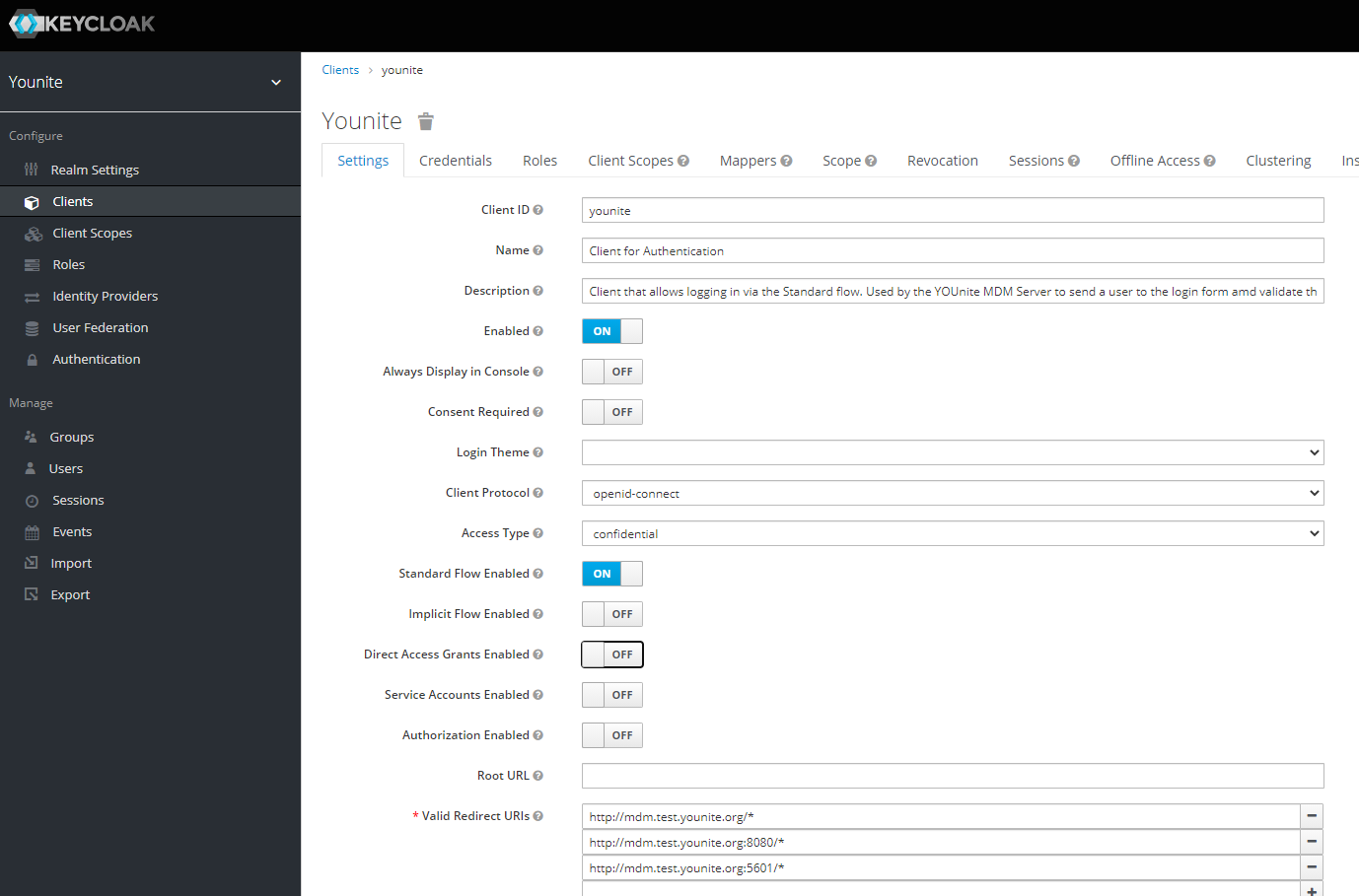
Select saveCredentials
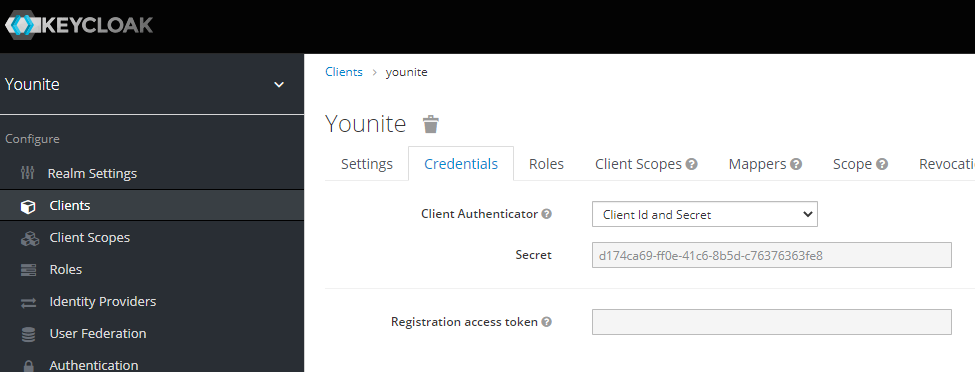
Creating the Client for the Notification Service
Under Clients, select add client and choose openid-connect as the client protocol. The client id MUST be
notifications to correspond to the permissions created for this service by default.
If it is desired to use a different client id for notifications, a record in the auth_identity table of YOUnite’s database
must be updated. For example: UPDATE auth_identity SET ssoid = '<new client id here>' WHERE ssoid = 'notifications'.
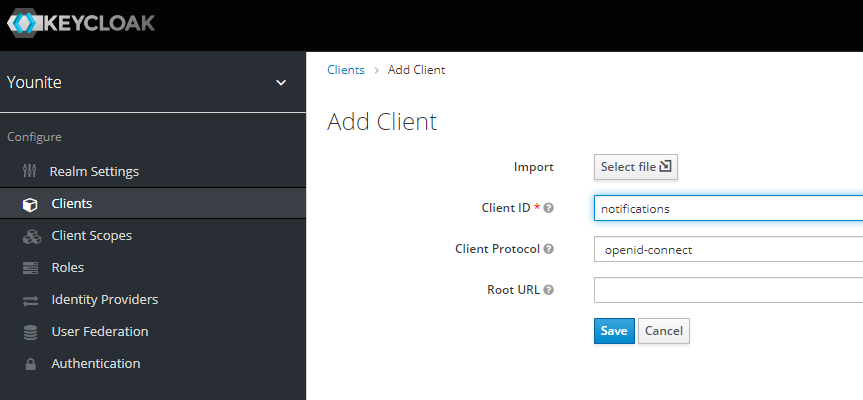
On the next page, set up your client like so. Make sure to set the following:
-
Access Type = confidential
-
Service Accounts Enabled = On
-
Disable all other authentication flows
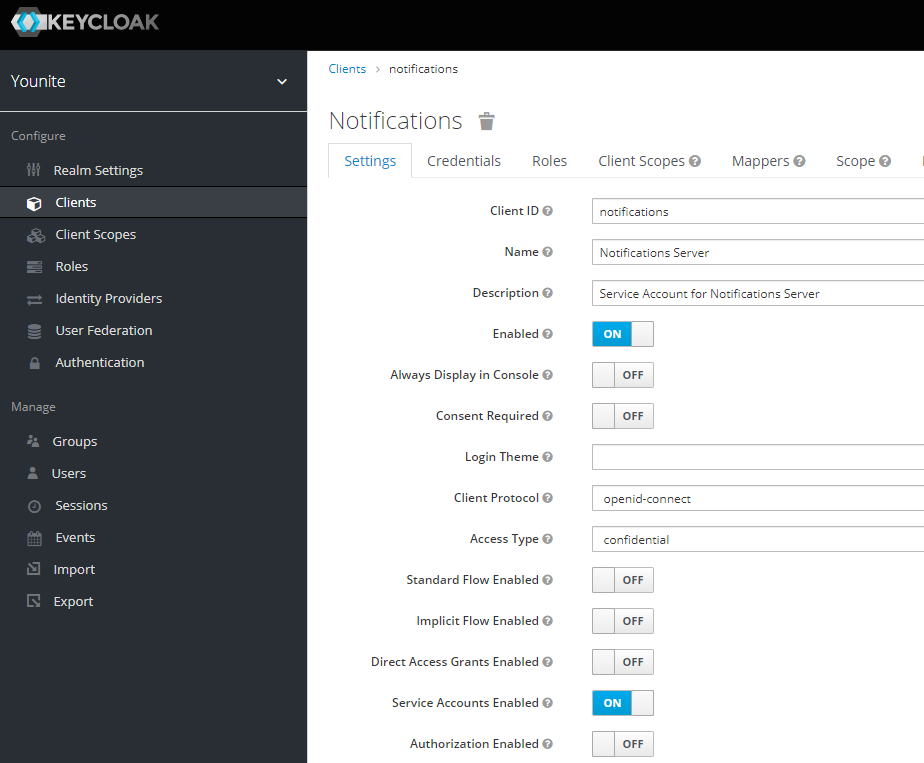
Select save after you’ve configured these options. Once you hit save, the Credentials tab will show up if it
was not present before. Click on that tab to retrieve the client secret. You will need this for later.
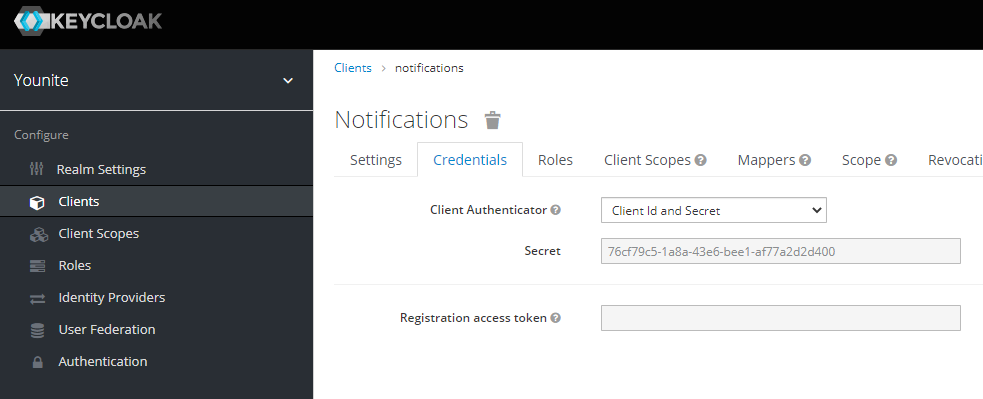
Configure Users
Next step is to create users. This example creates a user to correspond to the admin user with the email address admin@younite.us
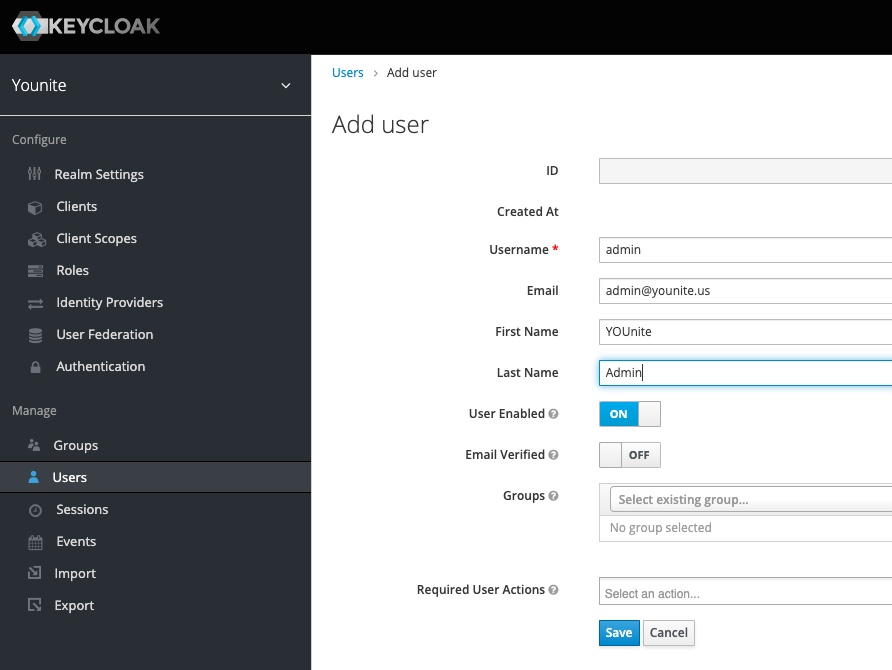
By default the new user won’t have a password, reset it like so:
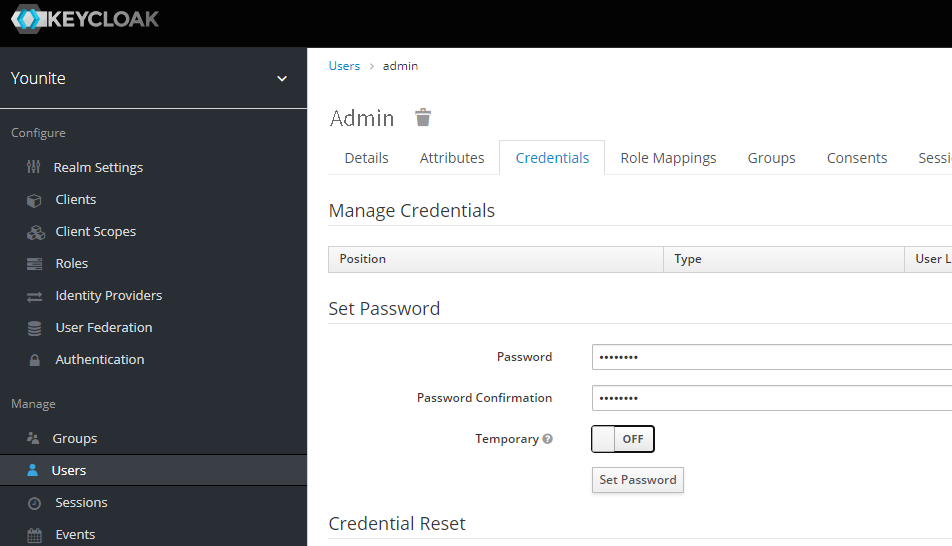
Default YOUnite Users
By default, YOUnite comes configured with two Super User accounts. An "admin" and a "data governance steward". The email addresses (or sso ids) of these users is admin@younite.us and dgs@younite.us. Therefore, for YOUnite to work out of the box, two accounts need to be created in Keycloak with these email addresses.
The email addresses of these two super users can be updated in the YOUnite database like so:
UPDATE auth_identity SET ssoid = '<new admin sso id>' WHERE ssoid = 'admin@younite.us'; UPDATE auth_identity SET ssoid = '<new data governancce steward sso id>' WHERE ssoid = 'dgs@younite.us';
Keycloak Configuration Variables
A Keycloak service is configured for a demo/eval deployment using the Docker Compose stack so, no extra configuration is required to be able to run Keycloak.
This implementation can be used as a starting point to build other SSO and OAuth services for YOUnite. To gain access to the YOUnite Keycloak repository contact your YOUnite Systems Integrator.
Its highly recommended that usernames, passwords and secrets are changed. Change the following if these or other changes are required.
| Property | Description | Default | Example |
|---|---|---|---|
KEYCLOAK_USER |
Realm master username |
None |
admin |
KEYCLOAK_PASSWORD |
Realm master password |
None |
admin |
REDIRECT_URIS |
Whitelist of redirect URIs (e.g. API, UI and Notification services) |
None |
"http://local.younite.org/*", "http://local.younite.org:8080/*", "http://local.younite.org:5601/*" |
YOUNITE_CLIENT_SECRET |
The client secret to assign to the |
None |
dcc766a6-de22-452e-9961-15db0cb4a5b6 |
NOTIFICATIONS_CLIENT_SECRET |
The client secret to assign to the |
None |
8da84bfb-0956-482b-8703-3f7210480aed |
TOKEN_LIFESPAN_SECONDS |
Token lifespan in seconds. |
24 hours (86,400 seconds) |
86400 |
DB_VENDOR |
The database vendor used. The YOUnite implementation uses h2. This value should not be changed. |
None |
h2 |
Configuring YOUnite Services for Keycloak
Now that Keycloak is configured, we need to set up the following services with information about the Open ID Connect server:
-
YOUnite API Service
-
Notification Service
-
UI Server
-
Data Virtualization Service
-
Elastic Service
-
Kibana Service
This configuration is done either in application.properties or via environment variables. The example below are values in environment variables:
Descriptions of each property are below in the comments:
YOUnite API Service Configuration
Open ID Connection information, required for authentication.
| Property | Description | Default | Example |
|---|---|---|---|
YOUNITE_API_URL |
URL to the public endpoint for the YOUnite API. Required for a redirect after authentication is completed. |
None |
|
OIDC_DISCOVERY_DOCUMENT_URL |
The URL of the discovery document with Open ID Configuration. |
None |
http://local.younite.org:8800/auth/realms/younite/.well-known/openid-configuration |
OIDC_CLIENT_ID |
Client ID. If using the default keycloak server, the value will be |
None |
younite |
OIDC_CLIENT_SECRET |
Client secret. If using the default keycloak server, the value will be the same as |
None |
8da84bfb-0956-482b-8703-3f7210480aed |
OIDC_SCOPE |
Scope to pass to the auth server. must include "openid", and typically the sso attribute we need, ie "openid email". |
None |
openid email |
OIDC_SSO_ATTRIBUTE |
Attribute(s) to map to SSO ID in the system. the default value is "email,clientId". the inclusion of clientId ensures that a client (such as the Notifications Service) can be authenticated as it may not have an email. |
None |
email,clientId |
OIDC_SUCCESSFUL_LOGIN_URL |
URL to send the user to when they successfully authenticate (such as the UI dashboard) |
None |
Notification Service Configuration
| Property | Description | Default | Example |
|---|---|---|---|
OIDC_ISSUER |
URI to the "issuer" of responses to OpenID requests. can be found in the discovery document as "issuer". |
None |
|
SSO_ATTRIBUTE |
Identify the field in the claims that identifies a user’s SSO ID (usually email). |
None |
|
NOTIFICATION_SERVICE_CLIENT_ID |
Client ID. If using the default keycloak server, the value will be |
None |
notifications |
NOTIFICATION_SERVICE_CLIENT_SECRET |
Client Secret. If using the default keycloak server, the value will be the same as |
None |
8da84bfb-0956-482b-8703-3f7210480aed |
UI Server Configuration
The UI needs to be configured with a SSO_TYPE of O
- SSO_TYPE=O # O = Open ID Connect, S = SAML (not yet supported)
|
Note
|
SAML is not currently supported but may be added in a future release |
| Property | Description | Default | Example |
|---|---|---|---|
SSO_TYPE |
Set to O for the default single-sign-on service Open ID. Contact your system integrator for other options. |
None |
O |
Data Virtualization Service Configuration
| Property | Description | Default | Example |
|---|---|---|---|
OIDC_ISSUER |
oic.issuer |
Issuer URI of the Open ID Connect compliant authentication server. Normally the same as used by the YOUnite server. |
|
OIDC_SSO_ATTRIBUTE |
oidc.sso.attribute |
Attribute that maps to the username in YOUnite, for example, email address. |
Elastic Service Configuration
| Property | Description | Default | Example |
|---|---|---|---|
OPENID_URL |
URL to the Open ID server to be used by Elastic. |
None |
http://local.younite.org:8800/auth/realms/younite/.well-known/openid-configuration |
Kibana Service Configuration
| Property | Description | Default | Example |
|---|---|---|---|
OPENID_URL |
URL to the Open ID server |
None |
http://local.younite.org:8800/auth/realms/younite/.well-known/openid-configuration |
OPENID_CLIENT_ID |
Typically, the same value used in API Service environment variable |
None |
younite |
OPENID_CLIENT_SECRET |
Typically, the same value used in API Service environment variable |
None |
8da84bfb-0956-482b-8703-3f7210480aed |
OPENID_REDIRECT_URL |
URL to the Kibana service. |
None |